Argentine Horned Frogs, also known as Pacman frogs or Ornate horned frogs, or Argentine wide-mouthed frogs, belong to the Ceratophryidae family, commonly known as South American horned frogs. The native South American frogs derive their name Pacman due to their round shape and large mouth which reminds the 1980’s popular arcade video game character Pac-Man. But are Pacman frogs or Argentine Horned Frogs good pets for households? Let’s find out.
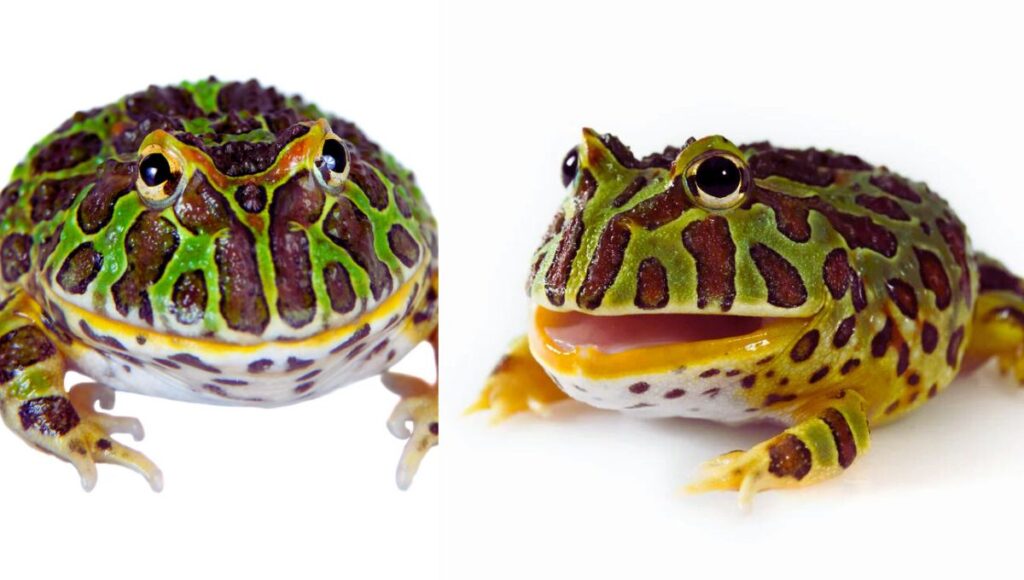
Table of Contents
Everything About Argentina Horned Frog:
In a Glimpse:
| Common Name | Argentine Horned Frogs |
| Scientific Name | Ceratophrys ornata |
| Other Names | Pacman frogs, Argentine wide-mouthed frogs, Ornate horned frog, Ornate horned toad, Ornate Pacman frog |
| Maximum Length | 4.5-6.5 inches |
| Maximum Weight | 320-450 grams |
| Ranges | South America |
| Habitat | Warm and Moist Environment with Water Source |
| Diet | Carnivore |
| IUCN Status | Near Threatened |
| Lifespan | 2-5 years |
Geographical Range:
Pacman frogs are the most common species of horned frogs and are completely endemic to South America. Argentine horned frogs are usually found in Argentina, Uruguay, and Brazil.
Habitat:
The South American amphibians prefer tropical rainforests and swamp areas as their home. Argentine horned frogs prefer grassland and savannah because in such habitats they find ample amounts of food and space to burrow and hide from predators.
As Argentine horned frogs are semi-aquatic animals, they are often found in swamp areas such as marshes, edges of ponds and rivers, temporary lakes, etc where they can easily access water for hydration as well as breeding.
Physical Characteristics: How do you identify Pacman frogs?
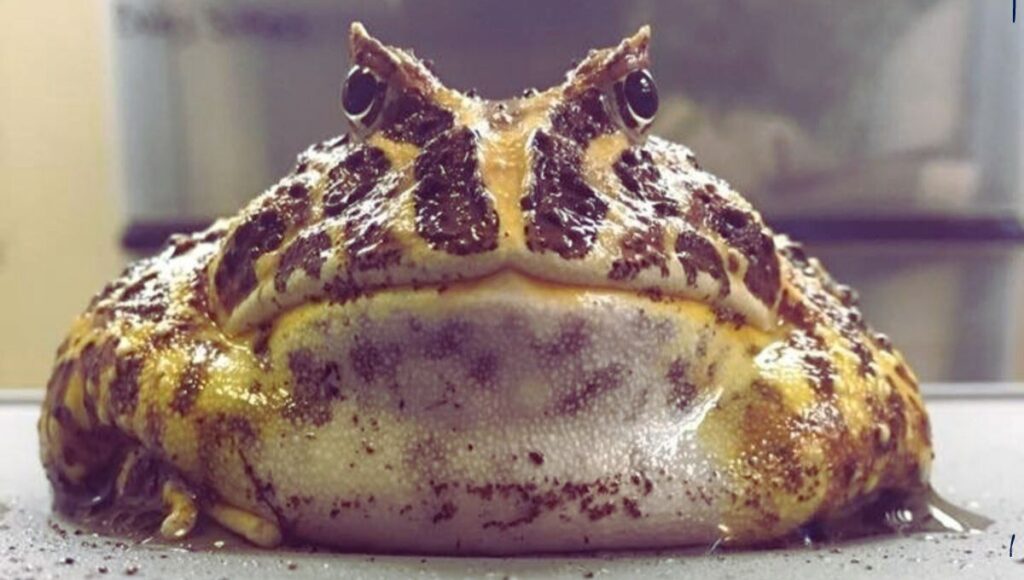
Argentine horned frogs are distinguished from other frogs for their heads which are half of their overall size. Sexual dimorphism is present in these frogs as the females are slightly bigger than the males. The snout-to-vent length of the males is 4.5 inches (11.5 cm) and the females are 6.5 inches (16.5 cm) long. Before reaching sexual maturity it is very difficult to differentiate males and females. However, males have dark-pigmented throats and nuptial pads on the forelimbs. The average weight of Pacman frogs is 320-450 grams.
Colors:
There are more than 40 pacman frog morphs present that exhibit a wide range of colours and patterns. The horned frogs usually have yellow or white underbellies. Their limbs and back consist of various colour combinations including various shades of colours like green, yellow, red, and brown.
Defense Mechanism: Are Pacman Frogs Poisonous?
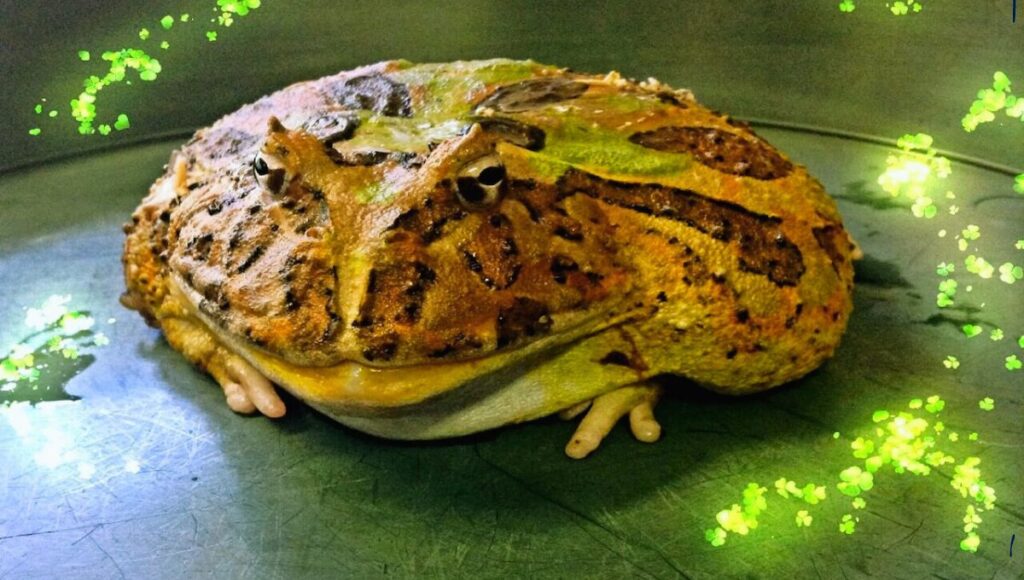
No, Pacman frogs are not poisonous or don’t secrete any venom as a part of their defence mechanism. However, the frogs are known to be extremely aggressive and fearless. Argentine horned frogs often attempt to consume animals that are much larger than their size and it results in suffocation.
If Argentine horned frogs are threatened by any larger predators or animals, they deliver a painful bite by their odontoid (toothlike structure) along the bottom and upper jaw. The bite is extremely painful and may require medical attention for humans. The horned frogs are so fearless that they often jump toward their attacker no matter how big or strong they are.
Diet:
Pacman frogs are completely carnivorous by nature however, the tadpoles are herbivorous as they sometimes consume algae. Mice, insects, small lizards, snakes, fish, amphibians, and other frogs are their primary diet. However, Argentine horned frogs often attempt to consume larger animals who cross paths with them.
Predators and Threats:
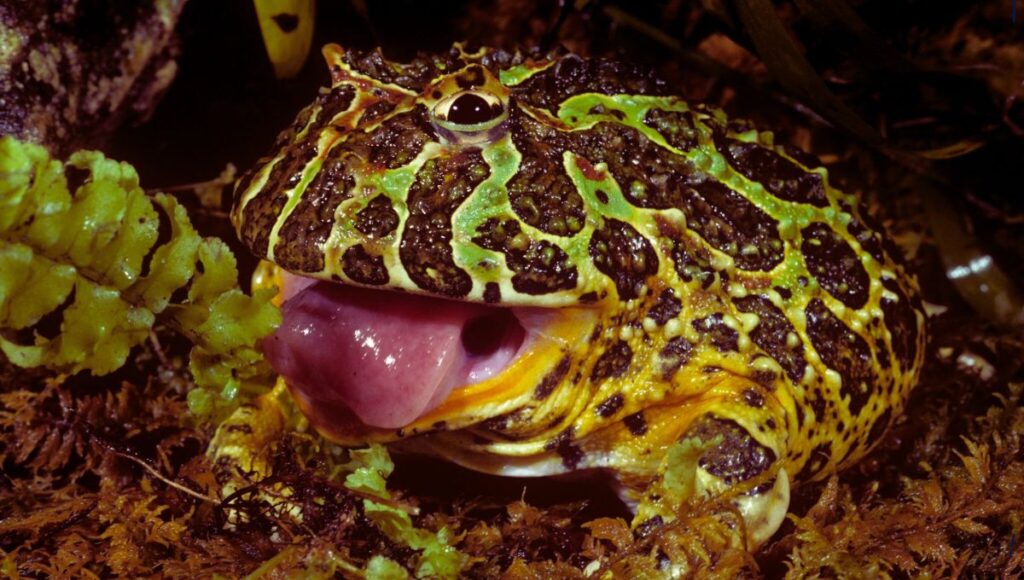
Beers, snakes, birds, and other wild animals are their main predators. However, Pacman frogs suffer a lot of anthropogenic threats to the environment. Habitat loss, environmental changes, dry weather, less rainfall, and pollution affect the population of Argentine horned frogs badly.
The local people often kill these frogs because they believe in the myth that the horned frogs possess venoms. Due to their alluring beauty, Pacman frogs are often poached and hunted illegally to sell in the international pet markets.
Conservation Status:
Argentine horned frogs are listed as “Near Threatened” in the IUCN Red List of Threatened Species as their population in the wild decreases rapidly.
Disease:
Like other amphibians, Pacman frogs are prone to being attacked by chytrid fungus which causes a deadly skin disease to the frogs (similar to Mountain Chicken frogs, American Bullfrogs, Pickerel frogs, Pixie frogs, etc). Other parasites also infect the frog species.
Lifespan:
Pacman frogs usually live 2-5 years in the wild. But in proper captive care, the horned frog species can live 10-16 years.
Behaviour:
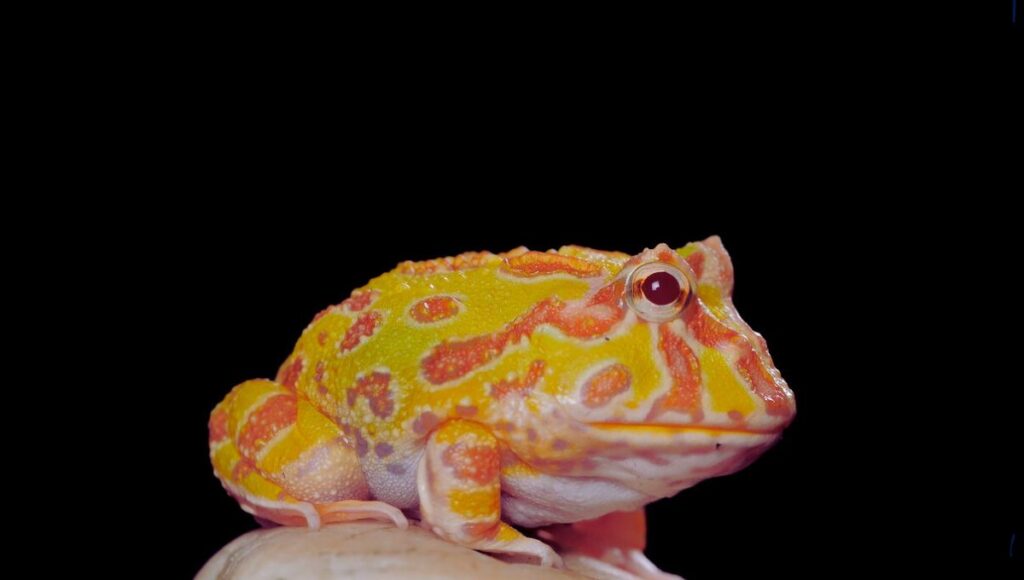
If the environment becomes dry and the humidity level decreases, the Argentine horned frog eventually loses its food source and it will enclose itself within a resilient outer layer of skin for protection. If you look at them, you may think of a live Pacman frog as a deceased one. Once the environment becomes moist and the frogs rehydrated, they shed the outer skin layer and ingest it.
Hunting Technique of Argentine Horned Frogs:
These horned frogs are very aggressive and their hunting style is very delusional. The frogs use camouflage so they can hide and wait in some greenery until the prey comes to their reach. Once the prey is available within their reach, frogs lunge and grab it with their strong jaws and teeth to kill and swallow the prey.
Physical Activity:
Pacman frogs can’t jump high but they can run at a speed of 5 mph or 8 kmph but for a short distance. These frogs are not good swimmers as well but they can swim in shallow water.
Vocalization:
The most common vocalization technique of the Argentine horned frog is the “Croak” sound which is used by males to attract females during mating season. As these frogs are nocturnal, you can hear the sound all night. The frogs also use long and high-pitched “Scream” sounds if they identify danger and if they are hungry, or during baths. When the frogs burrow and dig in the tank, their feet rub against the tank’s surface and can make a squeaky sound.
Ecological Importance:
As the frogs consume insects and rodents, Argentine horned frogs can be used in pest and rodent control.
Can You Keep a Pacman Frog As a Pet?
Pacman frogs can be a very good and exotic pet for beginners. Argentine horned frogs are rare but one of the most popular frogs in the pet industry due to their colour variations. The best thing about these horned frogs is they are very docile by nature and easy to care and once their habitat is set up, they are very low-maintenance pets. If you just want to look at the frogs and enjoy their activities, such as movements, hunting, etc, then these frogs can be very suitable frogs for you.

But there are some concerns also associated with Pacman frogs that you must know. The frogs are very aggressive and can attack any animal and human no matter how big and strong they are. The bites of the frogs are very painful and even require medical attention. There is a saying, if the Argentine horned frog bites the lip of a grazing horse, the horse will die from the bite. The bite force of the frog is approximately 30 Newton. Also, the amphibians are very prone to attacked by fungi and parasites and hence you need to check your frog every day. If you find any symptoms, consult your nearby veterinary surgeon.
The frogs have a voracious diet and they eat almost everything that passes by. The horned frogs also attack prey which is even bigger than them and it causes suffocation to the frogs. Pacman frogs also exhibit cannibalistic nature, hence you have to keep the frog alone in a container. Additionally, as the frogs are nocturnal, their “Croak” sound all night may hamper your sleep, Also, the frogs don’t like to be touched by humans, hence don’t touch it unless it is too necessary.
How do you buy an Argentine Horned Frog?
If you are interested in buying a Pacman frog, pick an active, alert frog that has clear eyes with skin free of blemishes. You can check the health condition of the frog by feeding it because only an ill Argentine horned frog will refuse food. Lethargy, bloated abdomen, and trouble in breeding also indicate that the frog is not healthy.
Try to buy these frogs from a reputed breeder who breeds and maintains the frogs in captivity. Avoid illegally captured frogs from the black market, because most of the time those frogs are not healthy. Ask for proof of origin and a health certificate from the breeder before buying. Also, be aware of the laws in your country or state about the frogs. You can buy these frogs from online platforms too but check reviews, policies, and other information before buying them.
The price of Pacman frogs depends on their age, sex, size, health condition, and the region where you belong. It is expected the frogs will cost around $15-$50. However, you’ll also need, a tank, substrate, water dish, decorators, food, light, foggers, thermometers, etc to maintain the frogs.
Requirements and Care:
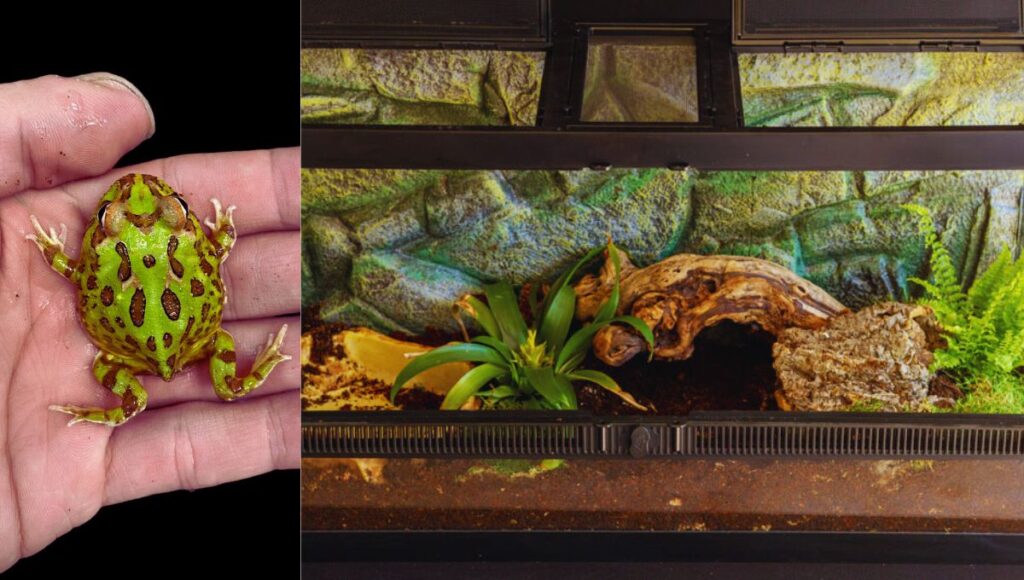
Enclosure:
Argentine horned frogs are not active enough and hence they don’t require large space. A 20-gallon tank with a secure lid and proper ventilation will be enough for one Pacman frog. However, due to low activity levels, these frogs are not known to escape the cage. You also need a shallow water dish that allows the frog to drink and sit in without drowning.
The tank must consist of paper or smooth rocks (that the frogs cannot swallow) with leaf litter or moss and some live or artificial plants as decoration. These decorations will allow the frog to hide and communicate with them, otherwise, it could cause boredom to the frogs.
Can a Pacman frog live with another Pacman frog or other species of frog in the same tank?
Pacman frogs are very aggressive by nature and show cannibalistic characteristics. Hence, it is not recommended to keep these frogs with other frogs in the same tank. They can kill other frogs, amphibians, or even their own species that live in the same tank, and consume them.
Substrate:
Argentine horned frog requires a moist environment and hence you need a substrate that can hold moisture. You can use coconut fibre, sterile potting soil, and sphagnum moss as ideal substrates as they can hold moisture. The substrate must be at least 2-3 inches deep, so the frogs can burrow or dig it, and misted daily to maintain the humidity of the enclosure.
Temperature and Humidity:
Argentine horned frogs require a warm and moist environment to survive. You must maintain around 82 degrees Fahrenheit during the day and 75-78 degrees Fahrenheit at night. Use a thermometer to monitor the temperature of the enclosure. If it is cold, use a heat lamp or heat mat to increase the temperature. But always avoid overheating the tank, or it’ll harm the frogs.
As the horned frogs prefer humid conditions, try to maintain the humidity at 60-80%. Use a hygrometer to monitor humidity. You can increase the humidity by using a fogger or by simply sprinkling water several times a day.
Light:
These frogs require a 12-hour day and night circle to regulate their daily activities. You can use low-wattage fluorescent bulbs or UVA/UVB lights as they provide the frogs with the necessary vitamin D.
Food and Water:
Pacman frogs are very easy to feed frogs and they don’t refuse food unless they are ill. You need to feed the tadpoles every day but when the frogs become adults, you can feed them every other day to prevent obesity. The amount of food they require depends on their age, sex, size, appetite level, and health conditions.
As these frogs are completely carnivorous, you can feed them with insects such as crickets, small reptiles, large spiders, locusts, gut-loaded mealworms, wax worms, and fish. However, the frogs also consume mice or pinky rats but don’t allow them to consume rats often. A study has proved that eating rats increases fat levels in these horned frogs which ultimately leads to blindness and even death. Also, give them only dechlorinated water free from germs.
Handling:
Argentine horned frogs don’t like to be handled by humans. If you want to communicate with the frogs by touching them, then it is not a good pet for you. If you want to communicate with the frog, feed it with a soft-tipped tong. Please don’t touch your frog unnecessarily, or it’ll create stress for them. Wear gloves before touching the frogs and wash your hands after. Also remember, that the bites of Pacman frogs are very painful, so be careful while handling them.
Cleaning:
You need to clean the water dish, waste food, and dead insects in the enclosure daily to prevent bacterial growth. However, once a month deep-clean the tank with a mild disinfectant and rinse it with dechlorinated water thoroughly. If the substrate doesn’t smell bad, change them every 10-12 weeks.
Health Issues:
Fungal infections on the skin and eyes of the amphibians are very common and Pacman frogs are no exception. If you notice any redness, swelling, or pus, it can be a sign of a fungal infection.
The horned frogs are also susceptible to parasitic infections. If the temperature of the enclosure is warm enough and the Argentine horned frog is not eating well, as soon as possible contact a veterinary surgeon to prevent overgrowth of parasites.
Without enough humidity, Pacman frogs suffer respiratory infections marked by wheezing, drooling, and lethargy. If you don’t clean the container properly and regularly, the frogs may suffer from ammonia poisoning. In such conditions, it is advised to consult a nearby veterinary surgeon as soon as possible.
Keeping Pacman frogs or Argentine horned frogs is comparatively easier than keeping other amphibians but sometimes it can be challenging for beginners. So, before buying your frog, do your own research and consult a veterinary surgeon for more information. Also, learn to respect your pet’s personal space, otherwise, it’ll show aggression and will cause trouble.
Reference: Wikipedia
Also Read:
Are Glass Frogs Suitable Pets for Beginners? Everything You Should Know Before Buying